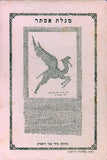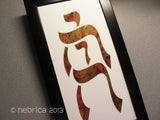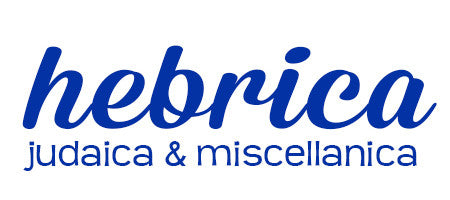The traditional Jewish notion of not making images comes from Exodus 20:4: "...you shall not make for yourself a sculptured image, or any likeness of what is in the heavens above, or on the earth below, or in the waters under the earth." After all, the Israelites had, just shortly before the Ten Commandments were handed down, made themselves a golden calf to worship and couldn't be trusted not to try it again.
 Certainly, through the ages, Jews regularly broke this commandment. There were even coins with various rabbis' faces on them! There were also work-arounds like micrography, making pictures with teeny letters - writing, not drawing, technically. The sefer Torah, the scroll, is never illustrated, but the megillot, like an Esther scroll, may be.
Certainly, through the ages, Jews regularly broke this commandment. There were even coins with various rabbis' faces on them! There were also work-arounds like micrography, making pictures with teeny letters - writing, not drawing, technically. The sefer Torah, the scroll, is never illustrated, but the megillot, like an Esther scroll, may be.
The tradition intended to draw a big fence around the Torah and, if we take the text literally, there would be no Jewish artists. But the urge to create, and by doing so, interpret, is a strong one. One of my earliest memories is reading Chaim Potok's My Name is Asher Lev, which is about this tension in Judaism between tradition and modernity. For some Jewish artists, the urge to create sent them away from Judaism entirely, to make art in the same style and on the same subjects as the non-Jewish artists around them. Others, like Marc Chagall, straddled the two worlds of Jewish art and secular art. Pious Jews have, for a very long time, created folk art form like the mizrach and the shiviti to focus their minds on Jerusalem and on prayer. Today, even very traditional Jewish organizations offer artwork on their websites.
 There is a midrash that talks about how every person is created "b'tzelim elohim," in the image of God. In fact, if you stack the letters that make up the unpronounceable name of God, yud-hey-vav-hey, you get a human form. It is a sort of "visual midrash" that goes beyond mere adornment to become a reminder of the bibilical passage:
There is a midrash that talks about how every person is created "b'tzelim elohim," in the image of God. In fact, if you stack the letters that make up the unpronounceable name of God, yud-hey-vav-hey, you get a human form. It is a sort of "visual midrash" that goes beyond mere adornment to become a reminder of the bibilical passage:
"...in the image of God He created him, male and female he created them." - Gen. 1:27
To subscribe to the Hebrica "Snippets" blog, enter your email address at the bottom of the page.
Copyright Notice: The contents of this site are copyrighted by Hebrica Judaic Art, all rights reserved. Republication by permission only, with a link back and the source of the republication clearly noted. Excerpts, commentary, and fair use applications should be accompanied by a link back to the original content on this site.

